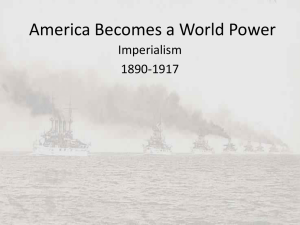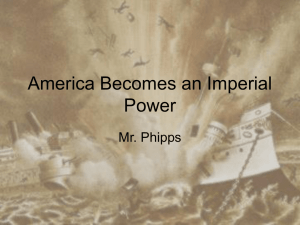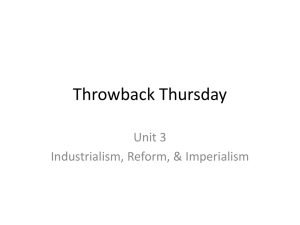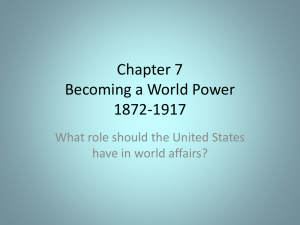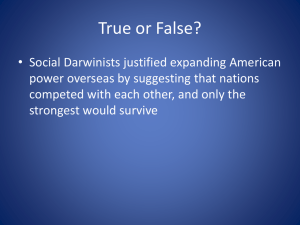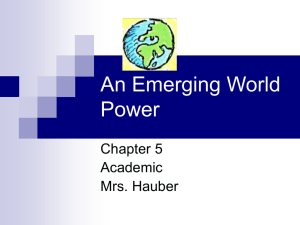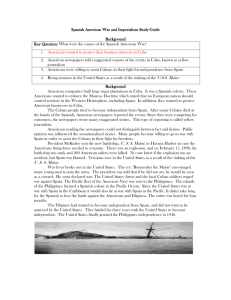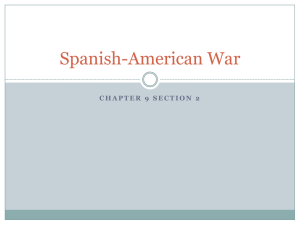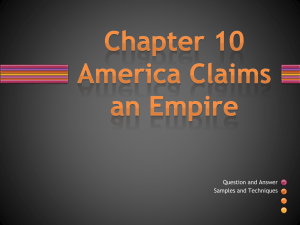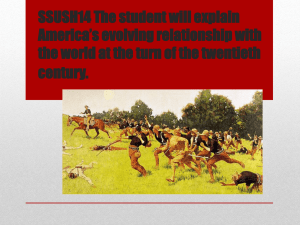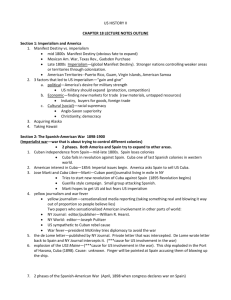AMERICA CLAIMS AN EMPIRE
advertisement
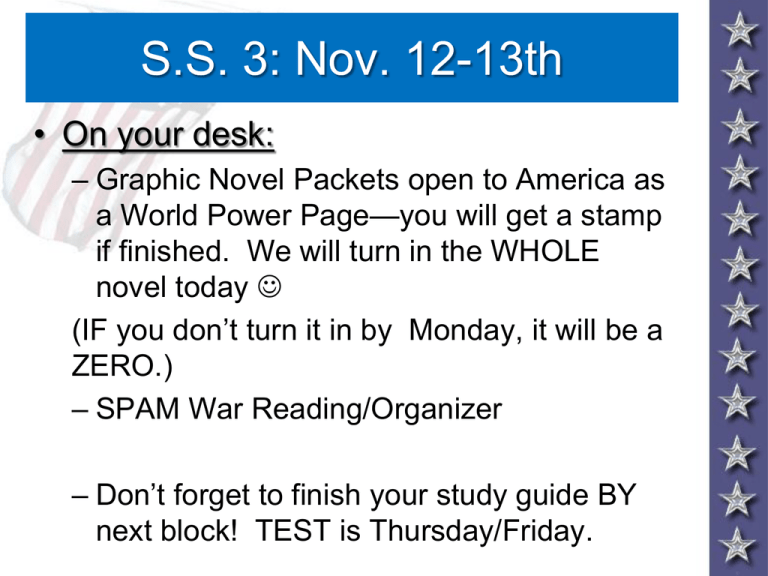
S.S. 3: Nov. 12-13th • On your desk: – Graphic Novel Packets open to America as a World Power Page—you will get a stamp if finished. We will turn in the WHOLE novel today (IF you don’t turn it in by Monday, it will be a ZERO.) – SPAM War Reading/Organizer – Don’t forget to finish your study guide BY next block! TEST is Thursday/Friday. When you finish… CHAPTER 10 AMERICA CLAIMS AN EMPIRE Spanish American War NOTES U.S. History with Cuba Cuba Versus Spain Legacy of the SPAM War Spanish American War U.S. has WAR fever America enters the war So What? • U.S. involvement in Latin America and Asia increased GREATLY as a result of the war and continues today. THE SPANISH AMERICAN WAR • America had long held an interest in Cuba • After Spain abolished slavery in Cuba in 1886, Americans invested millions in Cuban sugar Cuba is just 90 miles south of Florida CUBA’S SECOND WAR FOR INDEPENDENCE Marti • Anti-Spain sentiment in Cuba soon erupted into a second war for independence • Led by poet Jose Marti, Cuba attempted a revolution in 1895 • Marti deliberately destroyed property, including American sugar plants, hoping to provoke American intervention WAR FEVER ESCALATES • YELLOW JOURNALISM • Newspaper publishers William Randolph Hearst (New York Journal) and Joseph Pulitzer (New York World) exaggerated Spanish atrocities and brutality in “Headline Wars” Political cartoon: Pulitzer (left) and Hearst escalating and instigating war between the U.S. and Spain DE LOME LETTER • The New York Journal published a private letter written by Enrique de Lome, the Spanish minister to the U.S. • A Cuban rebel had leaked the letter criticizing McKinley as “weak” • The embarrassed minister resigned, BUT Americans were angry the Spanish had insulted their president. Ex. Minister De Lome U.S.S MAINE EXPLODES Before After • Early in 1898, President McKinley ordered the U.S.S. Maine to Cuba in order to bring home American citizens in danger • On February 15, 1898 the ship blew up in the harbor of Havana • More than 260 men were killed The Maine Explodes Unknown artist , 1898 Notice the men flying dramatically through the air WAR ERUPTS WITH SPAIN • Newspapers blamed the Spanish for bombing the U.S.S. Maine (recent investigations have shown it was a fire inside the Maine) • “Remember the Maine!” became a rallying cry for U.S. intervention in Cuba ROUGH RIDERS • Volunteer Calvary under Theodore Roosevelt • Most famous battle: San Juan Hill • Although his units played a minor role in the battle, the newspapers declared Roosevelt a war hero THE WAR IN THE PHILIPPINES • U.S. forces surprised Spain by attacking the Spanish colony of the Philippines • 11,000 Americans joined forces with Filipino rebel leader Emilo Aguinaldo • By August, 1898 Spain had surrendered to the U.S. in Manila THE WAR IN THE CARIBBEAN • A naval blockade of Cuba was followed by a land invasion highlighted by Roosevelt’s Rough Rider victory at San Juan Hill • Next, the American Navy destroyed the Spanish fleet and paved the way for an invasion of Puerto Rico (Spanish colony) END OF THE SPANISH AMERICAN WAR • Treaty of Paris was signed as a cease-fire agreement • War lasted only 15 weeks • Secretary of State John Hay called it “a splendid little war” WHAT HAPPENS WITH CUBA? • Spain relinquishes sovereignty over Cuba. • Platt Amendment (1901)– Cuba becomes a protectorate of the U.S.—(we can intervene with military or policy if a third party threatens) – ensured U.S. involvement in Cuban affairs and gave legal standing (in U.S. law) to U.S. claims to certain territories on the island including Guantanamo Bay U.S. WINS; SIGNS TREATY OF PARIS • The U.S. and Spain signed an armistice on August 12, 1898, ending what Secretary of State John Hay called “a splendid little war” • The war lasted only 16 weeks • Cuba was now independent • U.S. receives Guam, Puerto Rico, and “bought” the Philippines for $20 million Treaty of Paris, 1898 SECTION 3: ACQUIRING NEW LANDS • The U.S had to decide how to rule the new lands • Puerto Rico wanted their independence– but the U.S. had other plans • The U.S. set up a civil government, full citizenship, and a bicameral system had become a protectorate” of the U.S. FILIPINOS REBEL U.S. troops fire on rebels • Filipinos reacted with rage to the American annexation • Rebel leader Emilio Aguinaldo (guerilla warfare) vowed to fight for freedom and in 1899 he led a rebellion • The 3-year war claimed 200,000 Filipino rebels, 4,000 American lives and $400,000,000 (20x the price the U.S. paid for the land) • US Set up gov’t like Puerto Rico • Philippines would be independent on July 4, 1946. American/Philippines War • First true colonial war as a world power • $$ Costly China in Turmoil Social Studies 3: Monday • ON YOUR DESK: Graphic Novel Packet (with the Puerto Rico/Philippines page complete) • Today, we will discuss why we wanted to imperialize China. • Your Imperialism TEST will be Thursday/Friday. Your study guide is HOMEWORK…due that day. FOREIGN INFLUENCE IN CHINA • China was a vast potential market for American products • Weakened by war and foreign intervention, many European countries had colonized in China • In 1889, John Hay, U.S. Secretary of State, issued the Open Door Policy which outlined his plan for free trade among nations in China Foreign nations were opening the door to China’s trade BOXER REBELLION • European nations dominated China’s cities • Resentment arose in the form of secret societies determined to rid China of these “foreign devils” • The Boxer’s were a secret group that rioted in 1900, killing and vandalizing all things foreign • Foreign Troops were called in to put down this “Boxer Rebellion” AMERICANS PROTECT RIGHTS IN ASIA • After the Boxer Rebellion, John Hay again issued a series of Open Door Policies • These policies reflected American beliefs: – importance of exports – the right of America to intervene to keep foreign markets open – belief that America’s survival depended on access to foreign markets Diplomacy: • the management of communication and relationships between nations by members and employees of each nation's government America as a World Power • Label your CUES with the following main ideas: – Climb to #1 Status – The Panama Canal – Roosevelt Corollary/Big Stick Diplomacy – Taft’s Dollar Diplomacy – Wilson’s Missionary Diplomacy – Anti-Imperialism SECTION 4: AMERICA AS A WORLD POWER Super power status • Two events signaled America’s continued climb toward being the #1 world power • 1) Roosevelt negotiated a settlement between Russia and Japan who had been at War – his successful efforts in negotiating the Treaty of Portsmouth won Roosevelt the 1906 Nobel Peace Prize • 2) Construction of Panama Canal THE PANAMA CANAL • By the early 20th century, many Americans understood the advantages of a canal through Panama • It would greatly reduce travel times for commercial and military ships by providing a short cut between the Atlantic and Pacific oceans “The shortcut” BUILDING THE PANAMA CANAL 1904-1914 Cost- $380 million Workers– Over 40,000 (5,600 died) Time – Construction took 10 years • The French had already unsuccessfully attempted to build a canal through Panama • America first had to help Panama win their independence from Colombia – which it did • Construction of the Canal stands as one of the greatest engineering feats of all-time This view, provided by NASA, shows the thin blue line (canal) cutting across the middle of Panama Allowed the US to make huge economic gains!! Almost 1,000,000 ships have passed through the canal, which became sole property of Panama in the year 2000 Roosevelt’s “Big Stick” Policy • Latin American Countries owed vast amounts of money to European Nations • Roosevelt feared European powers might intervene • Monroe Doctrine stated Europe must stay out of Latin America • Roosevelt Corollary (ADDITION) stated would be used force Dollar Diplomacy • William Taft, Roosevelt’s successor continued to keep European Nations out of Latin America. • 1911-1933 – Taft arranged for American Banks to loan money to Nicaragua • This policy of using money to keep European Powers out of the Caribbean was called Dollar Diplomacy Wilson’s Missionary Diplomacy • Woodrow Wilson takes the Monroe Doctrine further, saying US may act on moral grounds • A violent revolution in Mexico leaves a brutal regime under General Huerta • Wilson sends troops to invade but withdraws after Huerta leaves Anti-Imperialists • Opposed expansion because they believed imperialism violated the credo of republicanism— “consent of governed” • Did NOT oppose expansion on commercial, constitutional, religious, or humanitarian grounds • Worried it meant the abandonment of American ideals of self-government and non-interventionism • Members such as Mark Twain, Samuel Gompers, and Andrew Carnegie WHY?? • game
